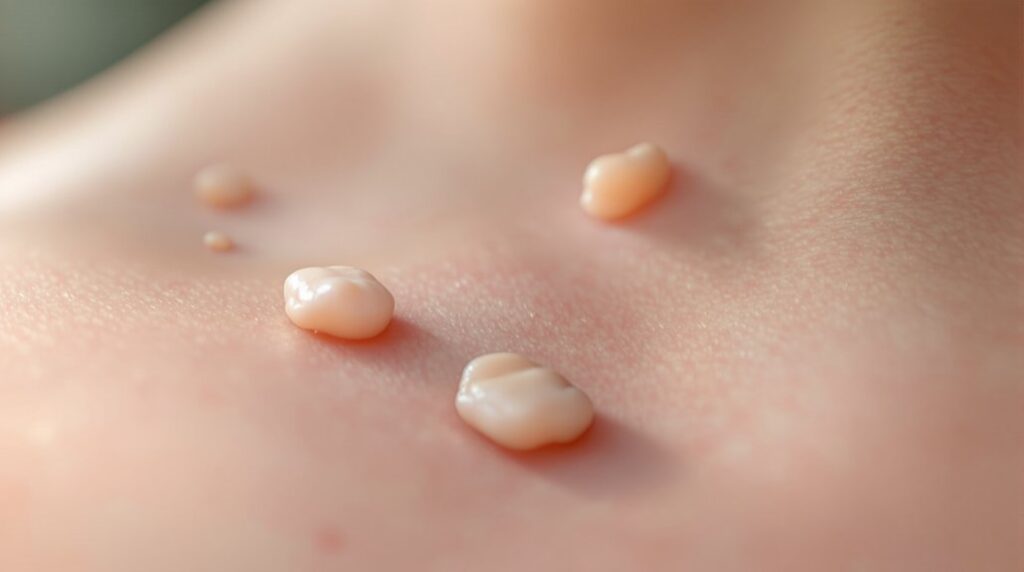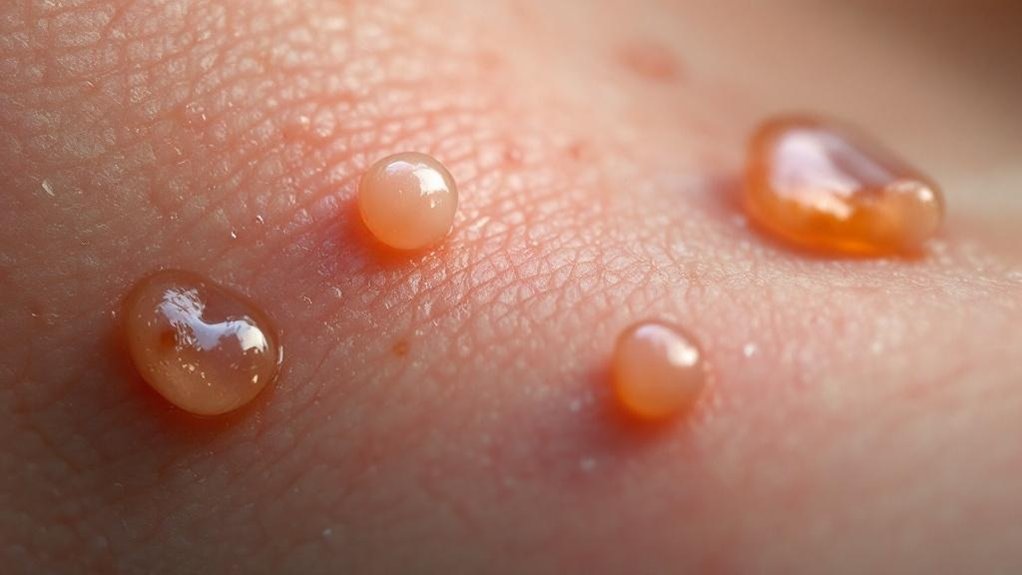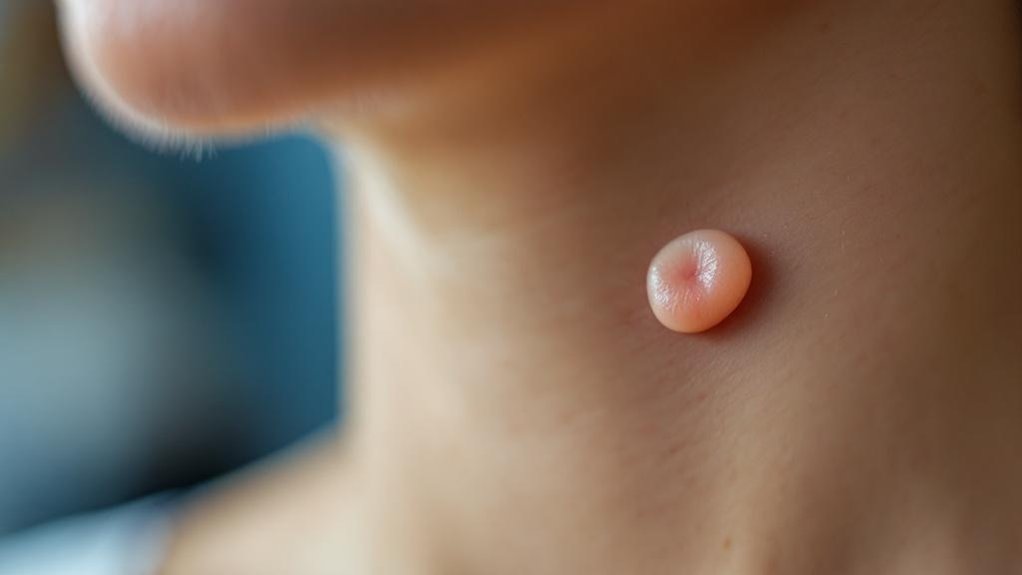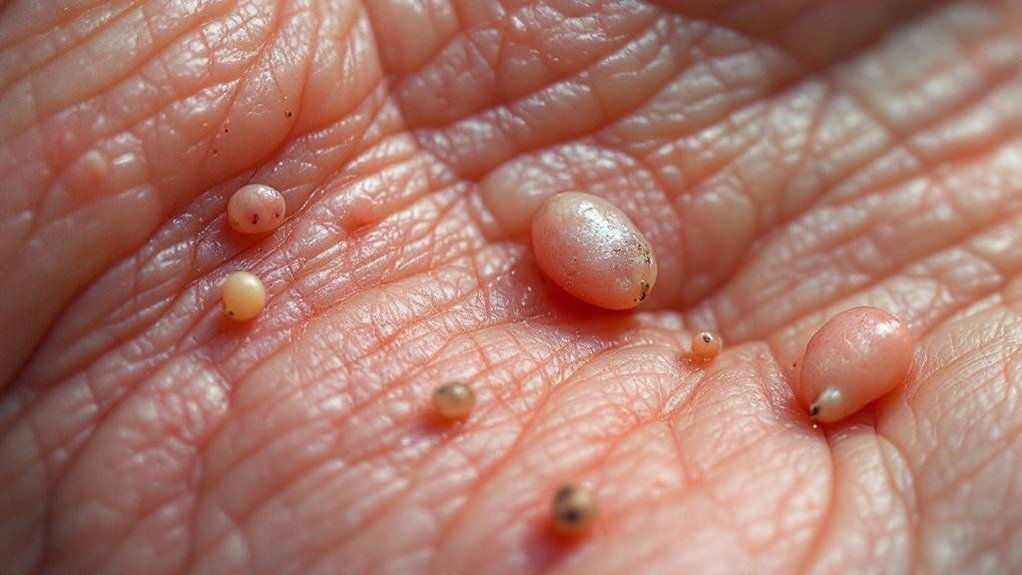Posted by: Skin And Cancer Institute in Uncategorized

Skin tags are benign cutaneous growths (acrochordons) that develop in areas of friction like the neck, axillae, and body folds. They’re associated with genetic predisposition, hormonal changes, and insulin resistance. While medical removal options include cryotherapy, electrodesiccation, and excision, over-the-counter solutions exist with varying efficacy. We recommend professional evaluation for tags that change in appearance, bleed, or develop suddenly. Further examination of treatment modalities can inform appropriate intervention selection.
Key Takeaways
- Skin tags are benign, soft, pedunculated growths that commonly appear in areas of friction like the neck and armpits.
- While the exact cause is unknown, skin tags may develop due to friction, hormonal changes, genetic predisposition, or insulin resistance.
- Professional removal options include cryotherapy (freezing), laser treatments, electrodesiccation, or surgical excision by a dermatologist.
- Over-the-counter treatments exist, but DIY removal methods can lead to complications like infection or scarring.
- Seek medical attention if skin tags change in appearance, bleed, cause pain, or develop suddenly in large numbers.
What Causes Skin Tags to Develop

While the exact etiology of skin tags remains multifactorial, several contributing factors have been identified in their pathogenesis.
These benign cutaneous neoplasms typically develop in areas of friction, including the neck, axillae, and intertriginous zones. Genetic factors play a significant role, with familial predisposition observed in numerous clinical cases.
Hormonal changes, particularly during pregnancy or in patients with endocrine disorders, can precipitate their formation through increased epidermal growth factor stimulation. We’ve documented correlations between skin tag development and insulin resistance, suggesting metabolic dysfunction as a contributing mechanism.
Additional risk factors include advancing age, obesity, and human papillomavirus infection. The histopathology typically reveals a polypoid architecture with a fibrovascular core and overlying acanthotic epidermis. We evaluate each patient’s unique presentation to determine the most appropriate treatment approach.
Common Locations Where Skin Tags Appear
Skin tags characteristically develop in anatomical locations where skin surfaces experience frequent friction or rubbing. These benign cutaneous acrochordons typically appear in the neck region, axillae (underarms), eyelids, and inframammary folds in women.
We frequently observe them in the groin area and inguinal creases as well. In our clinical practice, we’ve documented that obese patients often present with skin tags in body fold regions where perspiration accumulates. The common body areas for skin tag formation correlate directly with sites of repetitive dermal irritation. Skin tag characteristics include soft, pedunculated papules that may range from flesh-colored to hyperpigmented.
When examining patients, we assess distribution patterns of these fibroepithelial polyps, as multiplicity in certain anatomical zones can indicate underlying metabolic conditions requiring further investigation.
Medical Treatment Options for Skin Tag Removal

Dermatologists offer several evidence-based interventions for acrochordons removal, each with specific indications and contraindications. When you consult with our specialists, we’ll evaluate the anatomical location, size, and peduncle characteristics to determine the best treatment methodology.
Our clinical armamentarium includes cryotherapy options utilizing liquid nitrogen, which induces thermal injury to the lesion with minimal scarring potential. For patients with multiple or pigmented acrochordons, we may recommend laser treatments employing precise thermal energy that selectively targets the vascular components within the growth.
Additional modalities in our practice include electrodesiccation for hemostatic control, scissor excision for histological evaluation, and ligation techniques for pedunculated lesions. We are committed to harnessing cutting-edge technology for advanced care in skin conditions.
We’ll discuss potential post-procedural sequelae including transient erythema, minor discomfort, and healing timeframes during your consultation.
At-Home Remedies and Over-the-Counter Solutions
Many patients inquire about non-professional interventions for acrochordons management prior to seeking clinical care. We caution against DIY removal methods like cutting or tying off skin tags, which may lead to infection, scarring, or excessive bleeding—particularly in patients on anticoagulants. Several over-the-counter products contain salicylic acid or similar keratolytic agents that gradually break down skin tags.
However, efficacy remains clinically unsubstantiated. Natural treatments such as tea tree oil, apple cider vinegar, or vitamin E demonstrate minimal scientific validation despite anecdotal success reports. Proper skin care remains essential regardless of intervention choice.
We recommend maintaining the affected area clean and avoiding friction or irritation. Should at-home approaches prove inadequate, we welcome you to our practice for professional evaluation and treatment options.
When to Seek Professional Medical Attention

Although most skin tags are benign, there are specific circumstances that warrant prompt professional evaluation. We recommend seeking dermatological assessment if your skin tag exhibits any atypical symptoms concerning size, color, or texture changes. Rapid growth, bleeding, pain, or inflammation shouldn’t be dismissed as normal variations.
When multiple skin tags develop suddenly, particularly in conjunction with other systemic symptoms, this may indicate underlying metabolic disorders requiring thorough diagnosis options.
Additionally, tags in sensitive areas like eyelids or genitalia are best addressed by specialists with appropriate instrumentation.
We understand the uncertainty when facing skin abnormalities. Our dermatologists provide definitive identification, distinguishing skin tags from potentially serious conditions like melanoma or seborrheic keratosis, ensuring you receive appropriate treatment while maintaining peace of mind through expert guidance.
Frequently Asked Questions
Are Skin Tags Contagious or Can They Spread to Other People?
No, skin tags aren’t contagious. We regularly dispel skin tag transmission myths in our practice. These benign growths develop from friction but cannot spread between individuals through physical contact.
Do Skin Tags Grow Back After Removal?
Following complete removal, skin tags typically don’t recur in the same location. However, growth factors can stimulate new formations elsewhere. We utilize various removal methods to guarantee complete excision for our patients.
Can Skin Tags Be a Sign of Diabetes or Other Diseases?
Yes, skin tags can be indicators of diabetes mellitus and other metabolic conditions. We regularly assess these dermal growths as potential disease indicators, particularly when evaluating the diabetes connection in our extensive dermatological evaluations.
Are There Preventive Measures to Avoid Developing More Skin Tags?
We recommend maintaining healthy lifestyle habits, minimizing friction between skin folds, and implementing consistent skincare routines. While genetic predisposition exists, managing weight and avoiding irritating clothing can reduce occurrence.
Do Skin Tags Change Appearance if They Become Cancerous?
Skin tags don’t typically undergo cancerous transformation. We evaluate any changes in color, rapid growth, bleeding, or irregular borders—key skin tag characteristics that warrant immediate dermatological assessment in our patient community.
Conclusion
We’ve outlined the etiology, anatomical predilection, and therapeutic interventions for cutaneous acrochordons. Professional excision modalities—including cryotherapy, electrodesiccation, and sharp dissection—remain the gold standard for definitive resolution. While OTC preparations exist, their efficacy lacks robust clinical validation. Patients exhibiting atypical presentations, rapid growth, or concomitant systemic manifestations should undergo prompt dermatological evaluation. At Skin and Cancer Institute, we provide thorough histological analysis when clinically indicated.